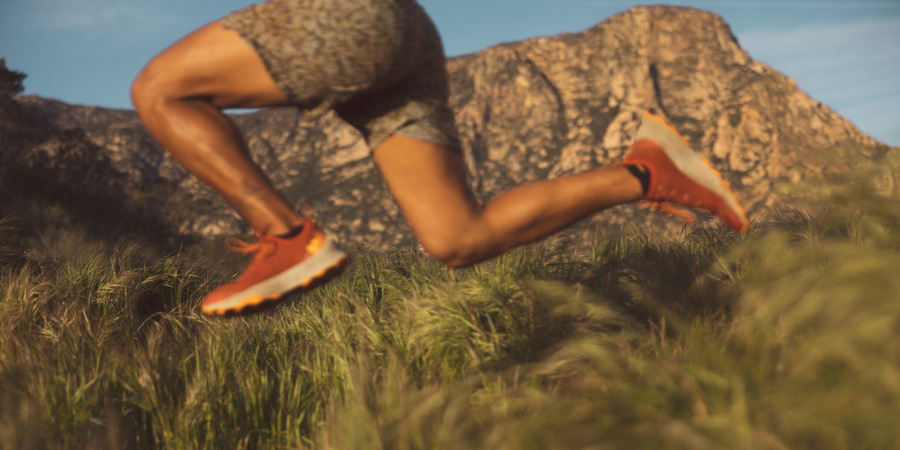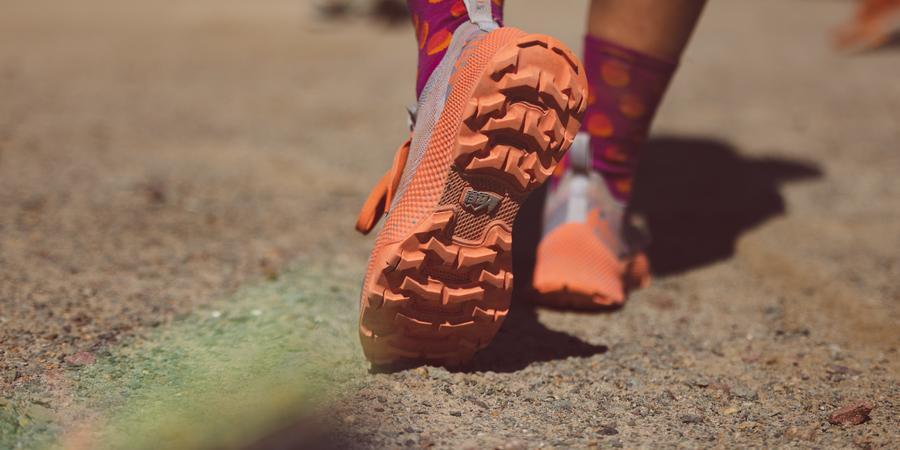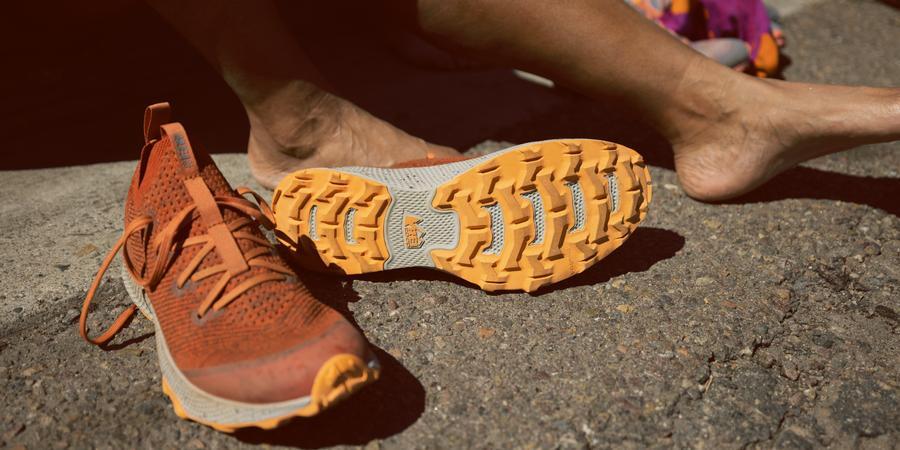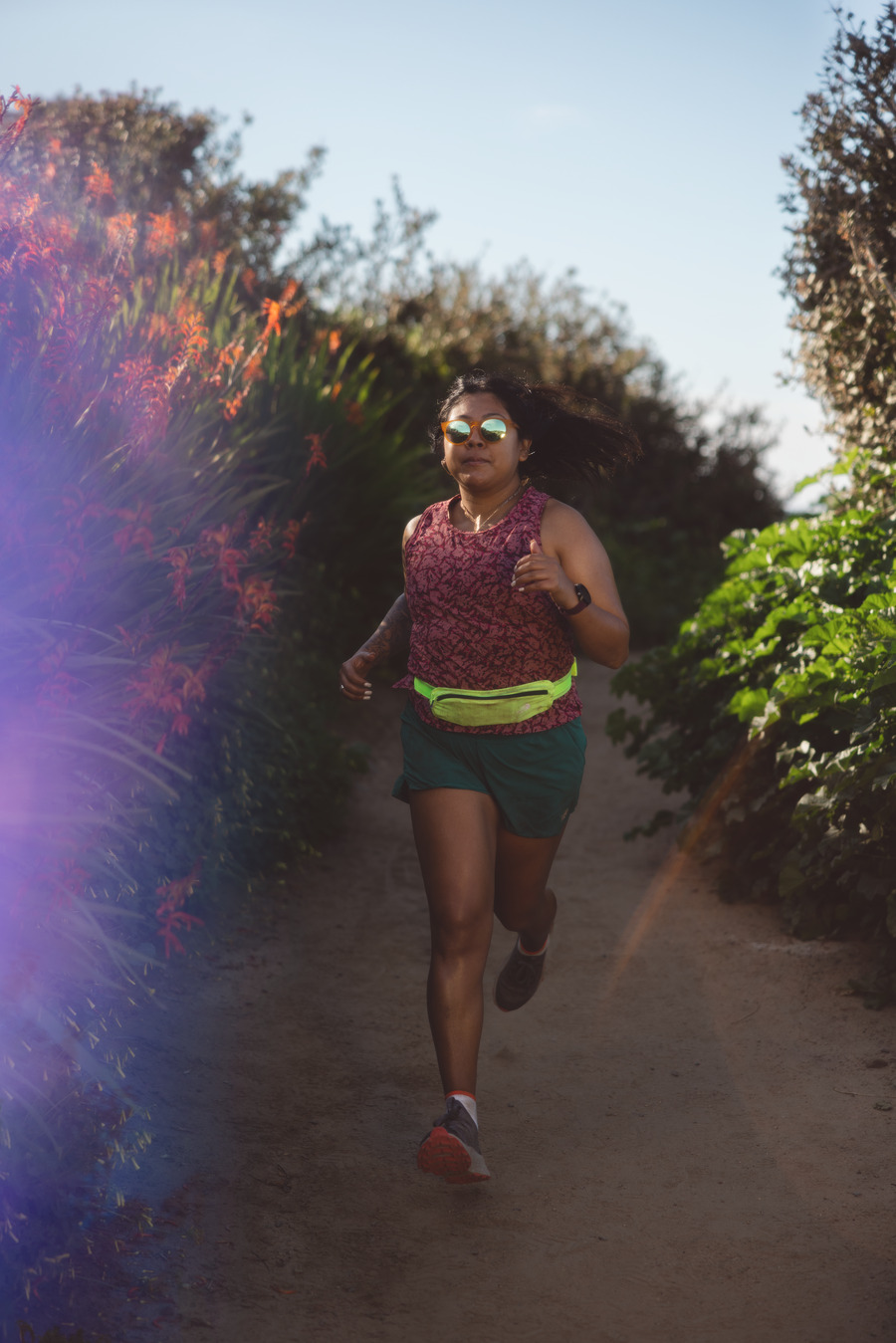Head to the shoe department of your local REI Co-op, and you’ll encounter an expansive display. Leather hiking boots with burly lugs are parked near low-top trail runners and performance sandals. Bright cherry red, tangerine and gecko-green hues mingle near subtle charcoals, taupes and chocolate browns. The line-up of brand names—HOKA, Salomon, La Sportiva and Chaco among them—reads like a who’s who of outdoor footwear’s elite.
But, until now, one obvious name has been hard to find.
While the REI Co-op brand name has graced a variety of gear, from packs and tents to running apparel and bikes, its logo has been limited on the shoe wall. There’s a hiking shoe and a walking shoe—but nothing for runners. That changed on June 1 with the launch of the Swiftland MT trail running shoes. (“MT” stands for “multi-terrain.”)
“We’ve been building industry-leading outdoor goods for a long time,” says Bennett Grimes, who led the shoe’s design process as senior product manager of innovation and footwear at REI. “We know the trail better than anyone.”
But that legacy alone isn’t enough to walk a footwear project forward. Coupling that passion and understanding for what makes a great product with innovations in sustainability and functionality: That is a good reason. REI is committed to “building products in a way that tries to limit our environmental impact,” Grimes says. “We wanted to make a shoe in a way that feels authentic to who we are and not just be another shoe on the wall.”
Designed to Be Different

There’s no question Grimes and his team have steep competition in the footwear department. Many of the brands REI carries have been making shoes for decades, with award-winning products that have crossed finish lines on the feet of trail legends like Courtney Dauwalter and Scott Jurek. Some of these brands have also been committing to more sustainable practices.
Grimes and his team wanted to do more. “There’s a clear gap in highly functional outdoor footwear when it comes to thinking through our carbon footprint and building a product,” he says. “We wanted to strike the right balance between comfort, durability and sustainability goals.”
Not only is this the right thing to do; consumers also expect it. Grimes points to data showing that shoppers factor sustainability efforts—or the lack thereof—into their decision-making processes generally, including in their footwear purchases, specifically. “If things are like for like, they’re going to gravitate toward the product that has a more carbon-friendly way of building,” he says, adding that this customer insight allowed his team to focus on sustainability efforts in a fresh and rigorous way.
REI Co-op already has a history of incorporating sustainable facets into all of its products, including its other footwear offerings. The breathable Flash Hiking Boots (available in men’s and women’s), first released in 2021, feature recycled materials and, according to one hiker from Rochester, New York, are “perfection for my feet.” And the co-op’s user-approved, “comfortable and stylish” Beyonder Shoes (available in men’s and women’s), which are designed for walking, have insoles made with 25% USDA-certified bio-based, petroleum-free Susterra® compound.
So, when the Swiftland MT team first began exploring the possibility of a trail-running shoe, there were two goals in mind: Minimized the creation cycle’s environmental impactful and still meet outdoorspeople’s rigorous performance standards. “As I’m sure you can imagine,” Grimes tells me, “that’s not an easy thing to do.”
Below the Surface

At first glance, the Swiftland MT looks like its trail-running counterparts from other brands. Its outsole—the bottom-most part of the shoe—features a thoughtfully designed lug pattern that offers solid footing on the trail. Its midsole—the middle, foam part of the shoe—has a squishy feel, but with its standard stack height and 8 mm offset, its profile resembles the average daily-trainer trail-running shoe competitor. Meanwhile, the upper—the portion that encases the foot—is made of a thin fabric layer and features typical shoelaces as opposed to, say, a Boa® lacing system.
Below the surface, however, the shoe lives up to the promise of “footwear with a lighter footprint.” Every component of the shoe is built with either recycled or bio-based materials, and it wowed more than 85 testers who wore the Swiftland MT through 2,500 miles of mud, sand and rocks in product trials.
I also tried out the shoe and found it ticked the boxes for solid footing and comfort on an array of terrain. On a 6-mile, leisure-paced outing on my favorite gravel path, I felt stable and confident–and notably, no pebbles snuck inside past the shoe’s sock-like opening. On rockier trails, the grip held firm, while on pavement, the Swiftland MTs hit the sweet spot for knee-approved cushioning: the midsole offers some give, but not too much. And they did all that in addition to turning heads and prompting impressed, “REI is making [running] shoes now?” queries.
The Swiftland MT weighs in at 10 ounces for a men’s size 9 (what Grimes calls the “sweet spot for lightweight without being a racing shoe”), and its dual performance and sustainability attributes start from the ground up. Underfoot, the proprietary TerraGripTM Run outsole offers confidence-inspiring grip and is made with 20% recycled rubber. “Across all rounds of of the trials, product testers felt that the shoe provided impressive traction and security against a wide variety of trail conditions,” says REI product researcher Bryan Jackler, who led the field-testing process. The outsole also stood up to industry durability ratings, which required testing for 300+ miles of wear. [Editor’s note: The field-testing process conducted by the co-op’s research and testing team for product development is separate from the field-testing process conducted by the co-op’s editorial team for tested gear guides in Expert Advice.]
TerraLoftTM Run takes center stage in the midsole. “This sounds kind of cheesy,” Grimes laughs, “but the goal was to create smile-inducing cushioning.” After multiple prototypes, they did. The foam layer is designed to help the user feel light and agile but not overly springy and out of control when progressing through their stride. Likewise, the proprietary foam feels comfortable underfoot but doesn’t cross over into momentum-zapping “pillowy” territory. During the testing phases, users reported the team nailed this sensitive formula: “Very responsive and cushioned enough for my taste,” says one.
But those aren’t the only attributes of TerraLoftTM Run worth smiling about. The foam also features 10% BLOOM™ Algae, a technology that turns waterway-clogging algae into a performance-level, EVA-algae-based hybrid foam. In effect, the Swiftland MT transforms plant matter into an ingredient for runner comfort.

In the shoe’s upper, FirmaKnitTM Run, a proprietary knit design that cradles the foot in a supportive sock fit, has multiple benefits. Its integrated tongue and foot-hugging collar prevent dirt and small rocks from sneaking into the shoe. In my own experience, the fit feels pliable yet secure thanks to content backers under the laces that create what Grimes calls a “midfoot lock-down.” (In other words, the foot stays put and the ankle remains supported.) Knitting the upper instead of using the industry-standard cut-and-sew technique reduces the amount of manufacturing waste. And, the FirmaKnitTM yarn is made from 90% recycled PET plastic that’s been purposely engineered to dry quickly, and I noticed it did dry faster than some of my other shoes from well-known trail brands. I was pleased to find in my own testing that the landfill-avoiding knit technique didn’t result in sacrifices in comfort or performance: A win-win.
A “multi-terrain” shoe has to perform well on many surfaces. Product testers reported that the Swiftland MT exceeded their expectations on moderately technical trails and dirt and gravel paths. They also ranked it higher than competitors in a blinded head-to-head trail run test during which they ran three loops using different shoes (the Swiftland MT and two others—all with their branding hidden) for each loop. The Swiftland MT was most frequently chosen as the favorite. “We wanted to build a shoe that was comfortable and easy to take on and off, but still offered enough technicality that you feel supported and protected, that would have really great grip under your feet so that you feel confident no matter what terrain you’re on,” Grimes says. “The Swiftland MT was us creating and innovating our own materials, pushing the industry forward, and testing and testing and testing and testing until we got it right.”
Getting More People Outside
All that technology (and testing; did Grimes mention testing?) ladders up to a performance-oriented trail shoe designed to help entry- and intermediate-level runners get out there. “How do we build a product that invites more people to be exploring unpaved paths and experience the spontaneity and excitement and freedom that that can bring? That [was] the ethos of what created this product,” Grimes says. “We just want to get more people out exploring the wilderness.”
It’s not just the shoe’s technical attributes that are intended to inspire users; the aesthetics are meant to do so as well. Rather than select glaringly bright colorways, the design team stuck with grounding hues like Pink Earth and Deep Orange that are both “outdoor-inspired and energetic,” says REI senior color designer Angela Patruno. She adds that the shoe’s body is eye-catching enough so that when looking down at your feet it’s like “following your friend,” while also being muted enough that they blend in with and belong in a natural setting. “When you’re running, you don’t want something that is distracting you or taking you out of the moment,” Patruno explains. “What we really wanted to maintain here was that you are in the outdoors, and the [Swiftland MT] is part of the experience.”
Making the outdoors accessible to more people has always been the drive behind the REI Swiftland trail running collection, which launched in 2021. The line includes running socks, insulated running jackets and member-favorite trail bottoms. (Customer reviewers have called the Swiftland 7” Running Shorts the “best running shorts ever.”) The Swiftland 5 Hydration Vest—designed specifically for male and female anatomy—is available in sizes up to 2X/3X. All these products hit mid-market price points to ensure they’re approachable cost-wise.

REI designers believe that adding the Swiftland MT, which falls on the less expensive end of the trail-shoe spectrum at $130 per pair, is a natural progression in the Swiftland line. If feedback from early testers is any indication, consumers will agree as they try the shoes for themselves. “There’s a ton of customer love,” Grimes says. “There’s excitement for what the Swiftland MT is, what it does and for having the brand name of REI on their feet.”
The hope is that once runners learn about the sustainability features behind the Swiftland MT, the shoe will impress them further, standing apart from its brethren on the footwear wall. As Grimes says, that was the “why” behind the project. It’s not, however, the finish line.
“When you’re a retailer like us, there’s an opportunity to really push the industry forward with something that we care about,” Grimes says about the REI commitment to increased sustainability. “I hope every brand tries to get as close as we did or surpasses where we’re going. … We need to start prioritizing every component if we want to protect the outdoors.”
The Swiftland MT seeks to do that, making an impactful step toward a footwear industry with a lighter impact.
